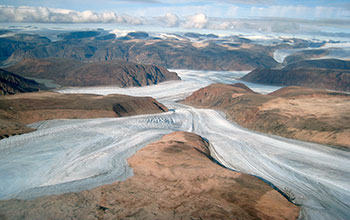Multimedia Gallery
Finding the Cause of the Little Ice Age (Image 3)
Converging outlet glaciers from large icecaps on northeast Baffin Island, Arctic Canada, where researchers from the University of Colorado Boulder studied the causes of what's known as Earth's Little Ice Age. [Image 3 of 9 related images. See Image 4.]
More About This Image
Professor Gifford Miller, a fellow at the University of Colorado (CU) Boulder's Institute of Arctic and Alpine Research, found that the Little Ice Age was caused by repeated explosive volcanism and was sustained by a self-perpetuating sea ice-ocean feedback system in the North Atlantic Ocean.
To reach these findings, Miller, who received funding from the National Science Foundation (NSF), and his team radiocarbon dated dead vegetation that they collected from rapidly melting icecaps on Baffin Island, as well as collected ice and sediment core data from the poles and Iceland and used sea ice climate model simulations.
Existing theories as to the cause of the Little Ice Age include decreased summer solar radiation, erupting volcanoes that cooled the planet by ejecting shiny aerosol particles that reflected sunlight back into space, or a combination of both. But Miller's study suggests that an unusual, 50-year-long episode of four massive tropical volcanic eruptions brought the onset of the Little Ice Age. Climate models produced by Miller and his team showed the persistence of cold summers following the eruptions is best explained by a sea ice-ocean feedback system that originated in the North Atlantic Ocean.
"This is the first time anyone has clearly identified the specific onset of the cold times marking the start of the Little Ice Age," said Miller. "We also have provided an understandable climate feedback system that explains how this cold period could be sustained for a long period of time. If the climate system is hit again and again by cold conditions over a relatively short period -- in this case from volcanic eruptions -- there appears to be a cumulative cooling effect."
The team also collected around 150 samples of dead plant material with the roots still intact that were gathered from beneath receding ice margins of icecaps on Baffin Island. The samples were radiocarbon dated, the results of which showed a large cluster of "kill dates" between A.D. 1275 and 1300, indicating the plants had been frozen and engulfed by ice during a relatively sudden event. Both low-lying and higher altitude species of plants all died at roughly the same time, indicating the onset of the Little Ice Age on Baffin Island was sudden.
The researchers also analyzed sediment cores taken from a glacial lake linked to the 367 square-mile Langjökull icecap, located in the central highlands of Iceland and reaching nearly a mile high. The researchers found that around the late 13th century and again in the 15th century, the annual layers in the cores suddenly became thicker (the cores can be reliably dated by using tephra deposits from known historic volcanic eruptions on Iceland going back more than 1,000 years). Miller says this was due to increased erosion caused by the expansion of the icecap as the climate cooled.
[Note: The field research in Arctic Canada was funded by NSF's Office of Polar Programs (OPP) (grants ARC 07-14074 and ARC 04-54662), the climate modeling was funded by NSF and NCAR computer time, and the field research in Iceland was funded jointly by the Icelandic Science Foundation (RANNIS) and OPP.]
Read more about this research in the CU news story New CU-led study may answer long-standing questions about enigmatic Little Ice Age. (Date of Image: July 2010)
Credit: Gifford H. Miller, INSTAAR, University of Colorado Boulder
See other images like this on your iPhone or iPad download NSF Science Zone on the Apple App Store.
Images and other media in the National Science Foundation Multimedia Gallery are available for use in print and electronic material by NSF employees, members of the media, university staff, teachers and the general public. All media in the gallery are intended for personal, educational and nonprofit/non-commercial use only.
Images credited to the National Science Foundation, a federal agency, are in the public domain. The images were created by employees of the United States Government as part of their official duties or prepared by contractors as "works for hire" for NSF. You may freely use NSF-credited images and, at your discretion, credit NSF with a "Courtesy: National Science Foundation" notation.
Additional information about general usage can be found in Conditions.
Also Available:
Download the high-resolution JPG version of the image. (3.7 MB)
Use your mouse to right-click (Mac users may need to Ctrl-click) the link above and choose the option that will save the file or target to your computer.

